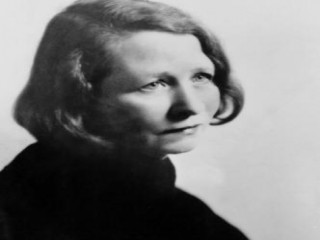
Edna St. Vincent Millay biography
Date of birth : 1892-02-27
Date of death : 1950-10-19
Birthplace : Rockland, Maine, U.S.
Nationality : American
Category : Famous Figures
Last modified : 2011-02-28
Credited as : Lyric poet, Renascence 1917, The Murder of Lidice
Edna St. Vincent Millay was an American lyric poet whose personal life and verse burned meteorically through the imaginations of rebellious youth during the 1920s.
Edna St. Vincent Millay was born in Rockland, Maine, on Feb. 27, 1892, and was educated in her native state. One of her juvenile poems appeared in St. Nicholas, and she delivered a verse essay at high school graduation. "Renascence," a long poem written when she was 19, appeared in The Lyric Year (1912), an anthology, and remains a favorite. A wealthy friend, impressed with Edna's talent, helped her attend Vassar College.
Following her graduation in 1917, Millay settled in New York's Greenwich Village and began to support herself by writing. Her impact was immediate with her first volume, Renascence (1917). She also wrote short stories under the pseudonym Nancy Boyd. A Few Figs from Thistles appeared in 1920. In 1921 she issued Second April and three short plays, one of which, Aria da Capo, is a delicate but effective satire on war.
In 1923 Millay published The Harp Weaver and Other Poems, which won the Pulitzer Prize, and married Eugen Jan Boissevain, and affluent Dutchman. In 1925 they bought a farm near Austerlitz, N.Y. Millay participated in the defense of the alleged anarchists Sacco and Vanzetti. In 1925 she was commissioned to write an opera with composer Deems Taylor; The King's Henchman (1927) was the most successful American opera to that time. That year, after the final sentencing of Sacco and Vanzetti, she wrote "Justice Denied in Massachusetts," a poem, and also contributed to Fear, a pamphlet on the case.
Millay issued Buck in the Snow (1928), Fatal Interview (1931), and Wine from These Grapes (1934). She tried a dramatic dialogue on the state of the world in Conversation at Midnight (1937), but the subject was beyond her grasp. She returned to the lyric mode in Huntsman, What Quarry (1939). Carelessly expressed outrage at fascism detracted from Make Bright the Arrows (1940); The Murder of Lidice (1942) was a sincere but somewhat strident response to the Nazis' obliteration of a Czechoslovakian town. She was losing her audience; Collected Sonnets (1941) and Collected Lyrics (1943) did not win it back.
Millay's last years were dogged by illness and loss. Friends died, and her husband's income disappeared when the Nazis invaded Holland. In 1944 a nervous breakdown hospitalized her for several months. Her husband died in 1949; on Oct. 19, 1950, she followed him. Some of her last verse appeared posthumously in Mine the Harvest (1954).
Miss Millay's virtues were in her poems speaking frankly about sex, the liberated woman, and social justice. Though she wrote in traditional forms, her subject matter, her mixed tone of insouciance, disillusionment, courage, and intensity and her lyric gifts were highly appreciated in her time.
















